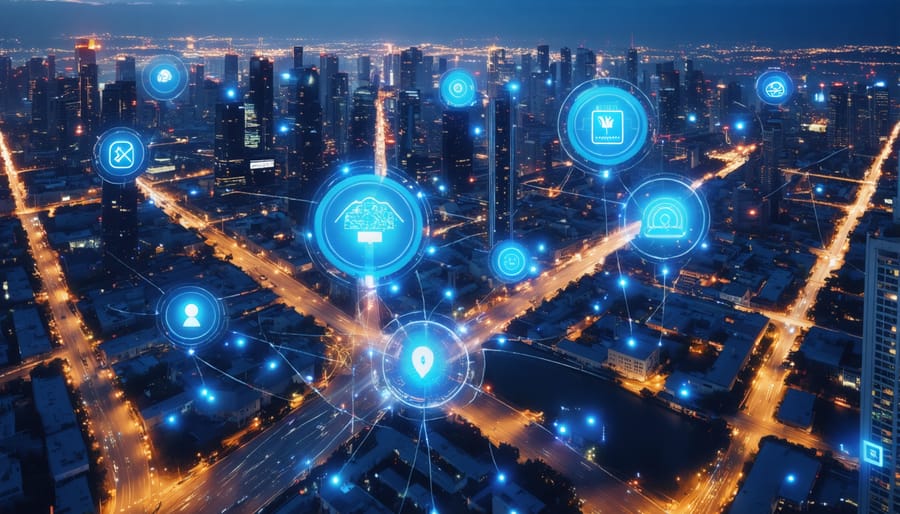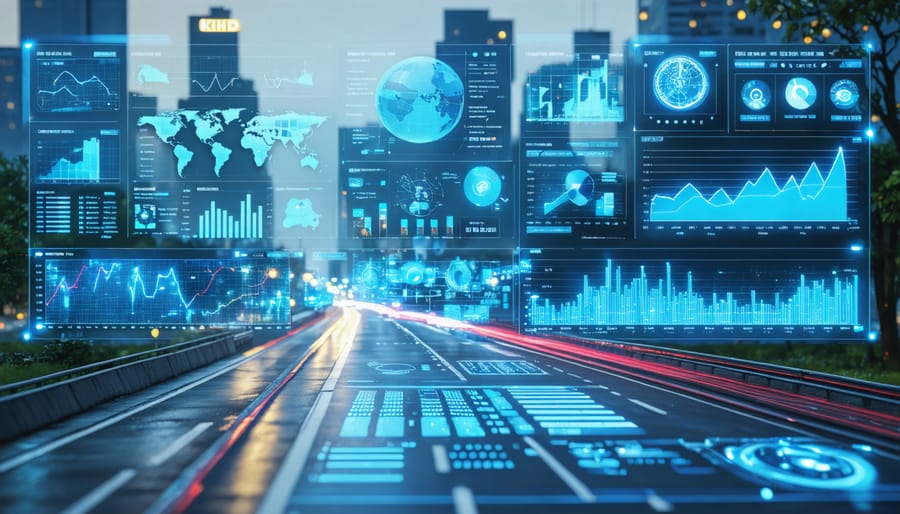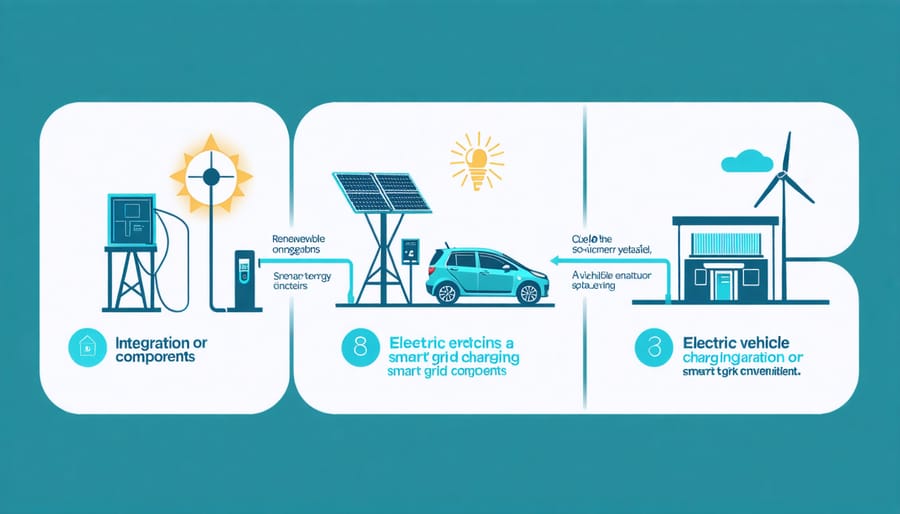Smart cities represent a transformative convergence of infrastructure, technology, and data analytics that is revolutionizing urban living across the globe. This integrated ecosystem leverages Internet of Things (IoT) sensors, advanced connectivity, and artificial intelligence to optimize city operations and enhance citizens’ quality of life. By seamlessly combining physical infrastructure with digital technologies, smart cities are redefining traditional urban development paradigms, enabling real-time monitoring and adaptive management of essential services from transportation to energy distribution.
The concept transcends mere technological implementation, embodying a comprehensive approach to urban planning that prioritizes sustainability, efficiency, and citizen engagement. As cities worldwide grapple with rapid urbanization, climate change, and resource constraints, smart city solutions offer practical frameworks for creating resilient, sustainable communities. These innovative urban environments utilize data-driven decision-making to address complex challenges, from traffic congestion and energy consumption to waste management and public safety, while fostering economic growth and environmental stewardship.
This evolution in urban development represents a critical intersection of construction expertise, digital innovation, and sustainable planning, setting new standards for modern metropolitan infrastructure and operations.

Core Components of Smart City Infrastructure
Digital Connectivity Networks
Digital connectivity networks form the nervous system of smart cities, with 5G technology and Internet of Things (IoT) serving as fundamental enablers of urban intelligence. The implementation of 5G infrastructure provides ultra-high-speed connectivity, minimal latency, and massive device connectivity capabilities essential for smart city operations. This advanced network architecture supports real-time data transmission across multiple urban systems, from traffic management to emergency services.
IoT deployment in smart cities typically involves a multi-layered network of sensors, actuators, and communication devices. These components work in concert to collect and transmit data about various urban parameters, including traffic flow, energy consumption, air quality, and infrastructure condition. Industry standards suggest a minimum density of 1,000 connected devices per square kilometer to achieve effective smart city functionality.
The communication infrastructure requirements encompass both physical and wireless elements. Fiber-optic networks serve as the backbone, providing the necessary bandwidth for data-intensive applications. Edge computing facilities, strategically positioned throughout the urban landscape, process data locally to reduce latency and network load. This distributed architecture ensures reliable service delivery even during peak demand periods.
Security considerations are paramount in smart city networks, necessitating end-to-end encryption and robust authentication protocols. The infrastructure must also be designed with redundancy and resilience in mind, incorporating backup systems and alternative communication pathways to maintain continuous operation during emergencies or system failures.
Intelligent Building Systems
Intelligent building systems form the cornerstone of modern smart cities, integrating advanced technologies to optimize resource utilization and enhance occupant comfort. These smart building systems leverage IoT sensors, artificial intelligence, and automated controls to create responsive environments that adapt to real-time conditions and usage patterns.
At the heart of these systems lies sophisticated energy management technology, which monitors and adjusts power consumption based on occupancy levels, time of day, and environmental conditions. Building automation systems (BAS) coordinate HVAC, lighting, security, and access control through centralized platforms, enabling facility managers to optimize operations while reducing energy waste.
Smart buildings incorporate predictive maintenance capabilities, using sensor data to anticipate equipment failures before they occur. This proactive approach minimizes downtime and extends infrastructure lifespan while reducing operational costs. Advanced analytics platforms process building performance data to identify optimization opportunities and enhance decision-making processes.
Integration with renewable energy sources and microgrids enables smart buildings to participate in demand response programs, contributing to grid stability while generating cost savings. Smart façades and dynamic shading systems automatically adjust to maximize natural light and minimize heat gain, further reducing energy consumption.
These intelligent systems also prioritize occupant well-being through indoor air quality monitoring, thermal comfort optimization, and personalized environmental controls, creating healthier and more productive spaces for building users.
Data-Driven Urban Planning
Real-Time Monitoring Systems
Real-time monitoring systems form the nervous system of smart cities, utilizing an intricate network of sensors and data collection points throughout the urban landscape. These systems continuously gather crucial information about traffic flow, air quality, energy consumption, waste management, and infrastructure health. Advanced IoT sensors, strategically placed across the city, monitor everything from structural integrity of buildings to pedestrian movement patterns.
The monitoring infrastructure typically consists of three key components: data collection devices, communication networks, and central processing systems. Environmental sensors measure parameters like temperature, humidity, and pollutant levels, while traffic sensors monitor vehicle flow and parking availability. Utility monitoring systems track water and electricity consumption patterns, enabling efficient resource distribution.
Data from these networks feeds into sophisticated analytics platforms that process information in real-time, allowing city managers to make informed decisions promptly. For instance, smart traffic management systems can automatically adjust signal timing based on current traffic conditions, while environmental monitoring can trigger immediate responses to air quality concerns.
These systems also support predictive maintenance of infrastructure, identifying potential issues before they become critical problems, thereby reducing maintenance costs and improving urban service reliability.

Predictive Urban Analytics
Predictive urban analytics represents a cornerstone of smart city development, leveraging artificial intelligence and machine learning to transform urban planning and infrastructure management. These sophisticated systems analyze vast datasets from multiple sources, including IoT sensors, traffic patterns, energy consumption metrics, and demographic information to forecast urban trends and optimize city operations.
Modern planning tools now incorporate real-time simulation capabilities, enabling city planners to visualize the impact of proposed developments before implementation. For instance, digital twin technology creates virtual replicas of urban environments, allowing stakeholders to test various scenarios and their potential outcomes. These simulations can predict traffic flow changes, assess environmental impact, and evaluate infrastructure capacity requirements with unprecedented accuracy.
AI-powered decision support systems help municipalities optimize resource allocation and respond proactively to urban challenges. These systems can predict maintenance needs for critical infrastructure, forecast population growth patterns, and identify potential areas for development. By analyzing historical data and current trends, they provide evidence-based recommendations for urban planning initiatives.
The integration of predictive analytics in smart city management has demonstrated significant benefits, including reduced operational costs, improved service delivery, and enhanced sustainability outcomes. Cities implementing these systems have reported up to 30% reduction in energy consumption and 25% improvement in emergency response times.

Sustainable Infrastructure Solutions
Smart Energy Grid Systems
Smart energy grid systems represent a cornerstone of modern urban infrastructure, integrating renewable energy sources with intelligent distribution networks to optimize power management and consumption. These systems employ advanced metering infrastructure (AMI) and sophisticated control algorithms to balance supply and demand in real-time, significantly reducing energy waste and operational costs.
The integration of solar panels, wind turbines, and energy storage solutions enables bidirectional power flow, allowing buildings to both consume and contribute energy to the grid. This distributed energy generation model enhances grid resilience and sustainability while minimizing dependency on traditional power plants.
Smart meters and sensors throughout the network provide granular consumption data, enabling precise load forecasting and dynamic pricing strategies. This data-driven approach helps utilities optimize grid operations and empowers consumers to make informed decisions about their energy usage.
Recent implementations in cities like Copenhagen and Singapore demonstrate the effectiveness of these systems in reducing carbon emissions by up to 30% while improving grid reliability. Energy storage technologies, including advanced battery systems and thermal storage, play a crucial role in managing peak loads and ensuring continuous power supply during high-demand periods.
The success of these systems relies heavily on robust communication infrastructure and cybersecurity measures to protect against potential vulnerabilities and ensure seamless operation of the power distribution network.
Eco-Friendly Transportation Networks
Smart cities prioritize sustainable and efficient transportation networks that seamlessly integrate various modes of transit while minimizing environmental impact. These networks leverage advanced technologies and data analytics to optimize traffic flow, reduce emissions, and enhance urban mobility.
At the core of eco-friendly transportation systems are Intelligent Transportation Systems (ITS) that utilize real-time data collection and analysis. Smart traffic management systems employ adaptive traffic signals that respond to current traffic conditions, reducing congestion and vehicle idle time. These systems work in conjunction with smart parking solutions that guide drivers directly to available spaces, significantly decreasing time spent searching for parking and associated emissions.
Electric vehicle (EV) infrastructure plays a crucial role, with cities implementing comprehensive charging networks and dedicated lanes for electric vehicles. Many smart cities are also introducing electric bus fleets and developing mobility hubs that integrate various transportation modes, including bike-sharing stations, EV charging points, and public transit connections.
Mobility-as-a-Service (MaaS) platforms are increasingly being adopted, allowing residents to seamlessly plan, book, and pay for multiple transportation options through a single interface. These systems encourage the use of public transit and shared mobility services while reducing private vehicle dependency.
Real-world implementations have shown that cities utilizing these integrated transportation solutions can achieve up to 30% reduction in traffic congestion and a 20% decrease in transport-related emissions, while significantly improving urban mobility efficiency.
Implementation Challenges and Solutions
Technical Integration Hurdles
The integration of diverse technological systems within smart cities presents significant technical challenges that require careful consideration and strategic planning. Legacy infrastructure compatibility remains a primary hurdle, as existing urban systems often operate on outdated protocols that resist seamless integration with modern IoT platforms and sensors.
Data standardization poses another critical challenge, with different systems and vendors using varied data formats and communication protocols. This heterogeneity complicates the creation of unified platforms necessary for effective city-wide management. Construction professionals must navigate these complexities while ensuring interoperability between new smart systems and existing infrastructure.
Security vulnerabilities emerge as systems become increasingly interconnected. The integration of multiple networks and devices creates potential entry points for cyber threats, necessitating robust security frameworks that don’t compromise system performance. According to recent industry studies, over 60% of smart city projects face delays due to cybersecurity concerns and integration complications.
Network capacity and reliability present additional technical hurdles. The massive data volumes generated by smart city systems require robust communication infrastructure capable of handling real-time information exchange. This often necessitates significant upgrades to existing network infrastructure, impacting project timelines and budgets.
Scalability remains a crucial consideration, as smart city solutions must accommodate future growth and technological advancement. Systems need to be designed with flexible architectures that allow for easy updates and expansions while maintaining operational efficiency. This requires careful planning during the initial implementation phases to ensure long-term sustainability and adaptability.
Financial and Policy Frameworks
The financial architecture supporting smart city initiatives typically encompasses multiple funding streams, including public-private partnerships (PPPs), municipal bonds, and international development funds. Local governments often establish dedicated smart city investment frameworks that combine traditional infrastructure financing with innovative funding mechanisms such as performance-based contracting and revenue-sharing models.
Key policy frameworks must address both technological integration and regulatory compliance. Cities worldwide are adopting comprehensive smart city policies that incorporate data governance, privacy protection, and cybersecurity standards. These policies are crucial for maintaining public trust while enabling technological innovation. Successful implementation requires alignment with existing urban development regulations and urban resilience planning strategies.
Investment considerations typically include both initial capital expenditure and long-term operational costs. Smart city projects often require substantial upfront investment in digital infrastructure, sensors, and control systems. However, the return on investment manifests through improved operational efficiency, reduced resource consumption, and enhanced service delivery.
Policy frameworks must also address standardization and interoperability requirements. This ensures that different smart city systems can communicate effectively while maintaining security and reliability. Many cities are now adopting open data policies and standardized APIs to facilitate system integration and encourage innovation from private sector partners.
Sustainable financing models increasingly incorporate green bonds and climate finance instruments, particularly for projects focused on environmental sustainability and climate adaptation. These funding mechanisms help cities achieve both smart technology implementation and sustainability goals while managing financial risks effectively.
The concept of smart cities represents a pivotal shift in urban development, combining technological innovation with sustainable infrastructure to create more livable, efficient, and resilient urban environments. As we’ve explored throughout this article, successful smart city implementation requires careful integration of digital technologies, sustainable practices, and human-centric design principles.
The future outlook for smart city development remains overwhelmingly positive, with global investment expected to reach $2.5 trillion by 2025. However, construction professionals must address several critical challenges, including data security, infrastructure integration, and ensuring equitable access to smart solutions across diverse communities.
Key success factors for future smart city projects will depend on strong public-private partnerships, standardized protocols for system interoperability, and adaptive infrastructure that can evolve with technological advancements. The construction industry must continue to embrace innovative building materials, IoT integration, and sustainable design practices while maintaining focus on end-user needs and community benefits.
Looking ahead, we can expect to see increased emphasis on resilient infrastructure, renewable energy systems, and AI-driven urban management solutions. The role of construction professionals will become increasingly multidisciplinary, requiring expertise in both traditional building practices and emerging technologies.
As we move forward, the true measure of smart city success will lie not just in technological sophistication, but in creating sustainable, inclusive urban environments that enhance quality of life for all residents while optimizing resource utilization and environmental protection.

